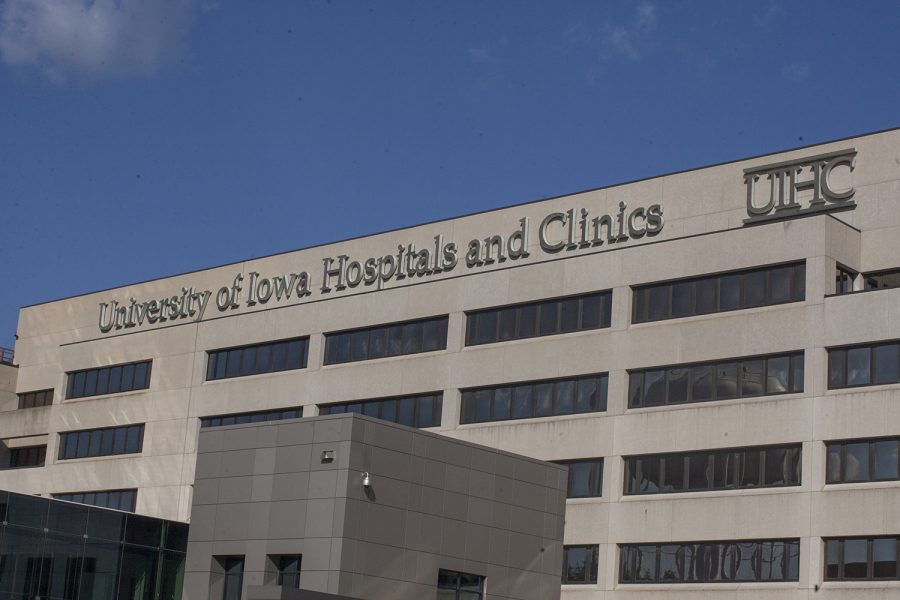University of Iowa Hospitals and Clinics sees increase in placenta problem
UIHC has seen an increase in the prominent pregnancy condition placenta accreta and is working to standardize protocol to address it in an effort to decrease the maternal mortality rate.
University of Iowa Hospitals and Clinics as seen on Sept 17, 2018.
April 8, 2019
University of Iowa Health Care specialists are seeing an increase in the rate of a pregnancy disorder known as placenta accreta. In an effort to combat the recent rise in the numbers of patients suffering the condition, UIHC is implementing a new protocol to treat complications.
Because of the complexity of placenta accreta, UI Clinical Associate Professor of obstetrics Andrea Greiner said, cases of it are historically referred to the university. In the last three and a half years, she said, UIHC has had approximately 40 patients deliver with accreta.
“Placenta accreta is a condition in pregnancy in which the placenta is abnormally implanted in the uterus,” Greiner said. “The placenta develops; it’s where the baby gets its nutrients and its blood flow.”
accreteGreiner said placenta accreta prohibits the placenta from peeling off and separating when the baby is delivered, and women who have placenta accreta are at significant risk of bleeding, needing blood transfusions, and possibly dying.
“When we started seeing the increase in these cases, in order to standardize the care for these women, we sat down and reviewed the medical literature to see what the best practices were,” Greiner said. “We then set up this protocol for how they enter our system.”
The protocol in question involves laying out what appointments incoming patients may need, laboratory tests, imaging, ultrasounds, magnetic resonance imaging, and any potential scenarios to go over.
“We make sure they have consultations ahead of time with all the different teams,” Greiner said. “To ensure that we have a live baby and a live mom.”
Women with placenta accreta must deliver in emergency protocol because of the risk of bleeding to death. Greiner said the goal is to avoid emergency deliveries and be prepared before the birth occurs.
RELATED: New UIHC CEO addresses achievements, issues for hospital
Greiner said the increased number of placenta accreta cases at the UIHC in the last four or five years are most likely the result of the high number of patients who have had C-sections. She wants to make a difference lowering the number of the latter and thus lower the risk of placenta accreta.
She admitted, however, that she probably won’t see that happen for a while, because C-sections have been going on for so long in the world of medicine. For the last 15 or 20 years, she said, the nationwide cesarean rate has risen approximately 30 percent.
Lori Wenzel, a obstetrician/gynecologist at Mercy Hospital Iowa City, said many patients prefer the option of a C-section over vaginal birth, and, although many doctors probably understand the possible consequences of several C-sections, they worry about legality in suggesting otherwise.
If patients want another baby after enduring placenta accreta, Wenzel said, they need to be prepared for blood transfusions during the delivery.
“It’s definitely one of the most dangerous conditions that is probably one of the leading causes of maternal mortality in today’s maternity population,” Wenzel said. “So most physicians are going to try remove the whole uterus with the placenta intact.”
Although UIHC has seen a substantial increase in placenta accreta compared with earlier years, UI Professor of obstetrics Kimberly Leslie said there is no definitive conclusion to why it is happening.
Nevertheless, she said, cesarean deliveries should still be viewed as something that is potentially going to affect the next pregnancy of the patient, more than the latter probably realizes.
The baby normally has to spend time in the Intensive Care Unit, she said, and usual protocol results in sterilization of the mother.
“Many of the women have had more than one delivery by C-section, so they do have a family, which is one saving grace,” Leslie said. “We hope to end up with another healthy baby, but it requires a substantial amount of work and extensive protocols to optimize outcomes.”





















